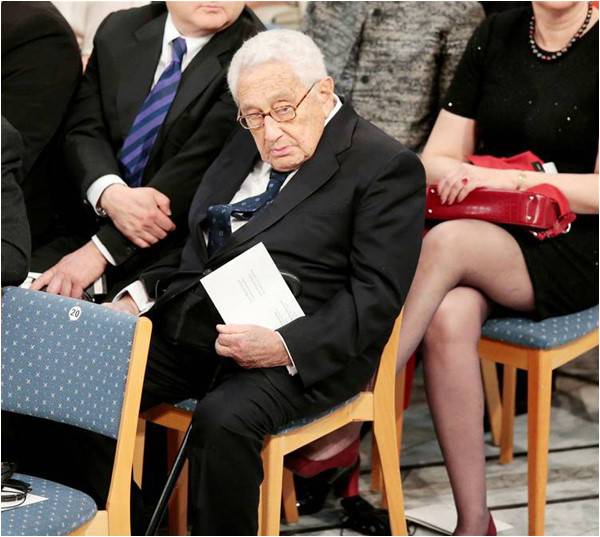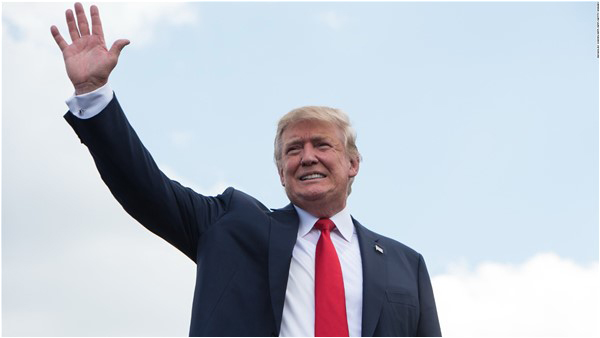
In the Trump multiplex, three shows are on simultaneously. First, came the announcement of the withdrawal from the Iran nuclear deal and we await the actual withdrawal. We must also observe how signatories respond at each step. Without the United States to lean on, will Britain ever survive a grouping in which Germany is the most muscular member? We must also consider the consequences of the American withdrawal from the deal for West Asia. Nail-biting suspense for the audience because no one will know what turn the events will take next.
Those smacking their lips at the prospect of Europe drifting away from the US would do well to delay celebrations. True, Donald Trump has just handed them money for jam by withdrawing from the deal, but as I have said above, between the announcement and the actual withdrawal, there is time for a slip.
Almost on cue, Israel has provocatively sought to escalate the Syrian conflict by attacking what it says are Iranian assets. Israel must have been very peeved at result of the elections in Lebanon. Hezbollah’s Hasan Nasrallahis is now indomitable in Lebanon’s politics.

The other big reversal for the US-led alliance is Syria itself. Iran was beginning to loom menacingly over Riyadh and Tel Aviv. Does Washington’s withdrawal from the deal bring Iran down a few notches? Or has the opposite happened? Iran looks dignified. It is Trump who has bartered away trust in America. He is replacing measured policy with caprice and impulse.
President Barack Obama and Secretary of State John Kerry sought to address the scene in West Asia differently. Their worldview was at a variance from Trump’s “non-world view”.
The Obama-Kerry approach to the Iran deal was conditioned by serious nuclear concerns, of course. But it was also a function of re-prioritising US role in world affairs in the context of China’s rise. The “pivot to Asia”, in their conception, required a more “hands–on,” focused attention to the Asia-Pacific region. They placed the Korean Peninsula in that framework. Diplomacy would advance US interests but without risking strategic alliances.
Having inadvertently enhanced Iranian stature by dismantling Taliban in Afghanistan (with Iran’s help) and Saddam Hussain in Iraq, the nuclear deal was one of the ways to manage Iranian power.
The deal had conferred legitimacy on the power structure in Tehran. A new balance of power in West Asia had become feasible. Tehran, Tel Aviv, Ankara, Riyadh and Cairo would be part of this pentagonal balance of power.
The Palestinian peace process, Syria’s civil war, the crisis in Yemen - all demanded American attention on a daily basis. This stalled the crucial “pivot”.
Obama and Kerry sought to place Tel Aviv, Riyadh and others in the same tent as Iran. This was anathema to Benjamin Netanyahu and Mohammad bin Salman. There was a frenetic stamping of feet at this prospect.
They were encouraged by the lobby in Washington’s think tanks, campuses, media and sundry Zionist groups which believed that the Israeli-Palestinian issue was no longer the West Asia’s core conflict. It had been superseded by the Shia-Sunni schism. This was now the basic fault line conditioning West Asian affairs. “No one talks of the Palestinian issue these days,” remarked a very old but alert Henry Kissinger during a talk at the Nobel Academy in Oslo two years ago.
The issue which underpinned Arab unity until the collapse of the Soviet Union in 1990-91 was Palestine. Thereafter, Iran remained a thorn in the sides of regimes where the streets were sensitive to the Palestinian tragedy – Egypt and Jordan, for instance. How did Iran aggravate the situation? By sustaining focus on the Palestinian issue during Friday prayer sermons by the supreme leader who often spoke of the disturbing news from Gaza or the West Bank. It was continuous crisis-management. Swollen ranks of the Muslim Brotherhood would cause Hosni Mubarak to go running to the Saudi King who opened his coffers for mosques and radio stations in Egypt which propagated exactly the political Islam which Saudi investments were supposed to quell.
Cairo’s discomfort was a source of anxiety for Tel Aviv, as well: the Egyptian regime, under the American yoke, was well-disposed towards Israel. But the Muslim Brotherhood’s growing links with Gaza were disturbing.
For the international community to remain consistently focused on the sectarian divide, the Palestinian issue needed to fade. With their combined clout, Tel Aviv and Riyadh succeeded in shifting focus to Shia perfidy against Israel and Saudi Arabia. Remember, how livid Netanyahu was with Obama? Totally ignoring the American president, he sailed above his head to address the US Congress.
There was an ironic twist to the tale. Excessive focus on the sectarian divide quite unintentionally brought anachronistic Wahabism under the global spotlight. This is one of the reasons for the Saudi crown prince’s impatient and risky gallop towards modernisation.
If the Israeli-Saudi duet considers Trump a Godsend, the partners should investigate qualities such as Trump’s attention span and his intellectual stamina. Can he stand by impulsive decisions until they acquire the outlines of policy? He announced he was leaving Afghanistan and then ordered a military surge in that country. High appointees have been in and out of Trump’s rotating door. What becomes of the CIA director-to-be Gina Haspal, a celebrated torture expert, will be watched with interest. His chilling endorsement of Haspel is chilling and in words that no American president or “leader of the free world” should utter. He made one’s hair stand when he said, “Torture works. Torture does work.”
Those smacking their lips at the prospect of Europe drifting away from the US would do well to delay celebrations. True, Donald Trump has just handed them money for jam by withdrawing from the deal, but as I have said above, between the announcement and the actual withdrawal, there is time for a slip.
Almost on cue, Israel has provocatively sought to escalate the Syrian conflict by attacking what it says are Iranian assets. Israel must have been very peeved at result of the elections in Lebanon. Hezbollah’s Hasan Nasrallahis is now indomitable in Lebanon’s politics.

The other big reversal for the US-led alliance is Syria itself. Iran was beginning to loom menacingly over Riyadh and Tel Aviv. Does Washington’s withdrawal from the deal bring Iran down a few notches? Or has the opposite happened? Iran looks dignified. It is Trump who has bartered away trust in America. He is replacing measured policy with caprice and impulse.
President Barack Obama and Secretary of State John Kerry sought to address the scene in West Asia differently. Their worldview was at a variance from Trump’s “non-world view”.
The Obama-Kerry approach to the Iran deal was conditioned by serious nuclear concerns, of course. But it was also a function of re-prioritising US role in world affairs in the context of China’s rise. The “pivot to Asia”, in their conception, required a more “hands–on,” focused attention to the Asia-Pacific region. They placed the Korean Peninsula in that framework. Diplomacy would advance US interests but without risking strategic alliances.
Having inadvertently enhanced Iranian stature by dismantling Taliban in Afghanistan (with Iran’s help) and Saddam Hussain in Iraq, the nuclear deal was one of the ways to manage Iranian power.
The deal had conferred legitimacy on the power structure in Tehran. A new balance of power in West Asia had become feasible. Tehran, Tel Aviv, Ankara, Riyadh and Cairo would be part of this pentagonal balance of power.
The Palestinian peace process, Syria’s civil war, the crisis in Yemen - all demanded American attention on a daily basis. This stalled the crucial “pivot”.
The deal had conferred legitimacy on the power structure in Tehran. A new balance of power in West Asia had become feasible
Obama and Kerry sought to place Tel Aviv, Riyadh and others in the same tent as Iran. This was anathema to Benjamin Netanyahu and Mohammad bin Salman. There was a frenetic stamping of feet at this prospect.
They were encouraged by the lobby in Washington’s think tanks, campuses, media and sundry Zionist groups which believed that the Israeli-Palestinian issue was no longer the West Asia’s core conflict. It had been superseded by the Shia-Sunni schism. This was now the basic fault line conditioning West Asian affairs. “No one talks of the Palestinian issue these days,” remarked a very old but alert Henry Kissinger during a talk at the Nobel Academy in Oslo two years ago.
The issue which underpinned Arab unity until the collapse of the Soviet Union in 1990-91 was Palestine. Thereafter, Iran remained a thorn in the sides of regimes where the streets were sensitive to the Palestinian tragedy – Egypt and Jordan, for instance. How did Iran aggravate the situation? By sustaining focus on the Palestinian issue during Friday prayer sermons by the supreme leader who often spoke of the disturbing news from Gaza or the West Bank. It was continuous crisis-management. Swollen ranks of the Muslim Brotherhood would cause Hosni Mubarak to go running to the Saudi King who opened his coffers for mosques and radio stations in Egypt which propagated exactly the political Islam which Saudi investments were supposed to quell.
Cairo’s discomfort was a source of anxiety for Tel Aviv, as well: the Egyptian regime, under the American yoke, was well-disposed towards Israel. But the Muslim Brotherhood’s growing links with Gaza were disturbing.
For the international community to remain consistently focused on the sectarian divide, the Palestinian issue needed to fade. With their combined clout, Tel Aviv and Riyadh succeeded in shifting focus to Shia perfidy against Israel and Saudi Arabia. Remember, how livid Netanyahu was with Obama? Totally ignoring the American president, he sailed above his head to address the US Congress.
There was an ironic twist to the tale. Excessive focus on the sectarian divide quite unintentionally brought anachronistic Wahabism under the global spotlight. This is one of the reasons for the Saudi crown prince’s impatient and risky gallop towards modernisation.
If the Israeli-Saudi duet considers Trump a Godsend, the partners should investigate qualities such as Trump’s attention span and his intellectual stamina. Can he stand by impulsive decisions until they acquire the outlines of policy? He announced he was leaving Afghanistan and then ordered a military surge in that country. High appointees have been in and out of Trump’s rotating door. What becomes of the CIA director-to-be Gina Haspal, a celebrated torture expert, will be watched with interest. His chilling endorsement of Haspel is chilling and in words that no American president or “leader of the free world” should utter. He made one’s hair stand when he said, “Torture works. Torture does work.”

